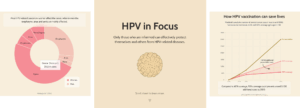Scrolling with Purpose: A Pilot Study on Usability and Comprehension Effects of Scrollytelling in HPV Vaccination Communication
Aim and Research Question(s)
This thesis examined whether a Scrollytelling website, in which information unfolds dynamically while scrolling, can enhance understanding of HPV vaccination data compared to a static website. The pilot study aimed to explore how an interactive format can improve clarity and comprehension of complex health information. The research questions were:
- To what extent does the use of Scrollytelling elements in an interactive website for presenting HPV vaccination data reduce errors in interpreting and navigating information?
- What design principles and interactive elements contribute to a better comprehension of HPV vaccination data?
Background
Human papillomaviruses (HPV) are among the most common sexually transmitted infections worldwide and cause several types of cancer. Still, traditional health communication strategies often fail to capture attention or promote understanding [1]. Scrollytelling offers a promising alternative by combining visual storytelling with user-driven interaction. This research builds on insights from data visualization, health literacy, and user experience design to address the challenge of improving digital health communication.
Methods
Based on the findings of a literature review, two prototype websites were developed: a dynamic Scrollytelling version and a static version. In the pilot study, participants (n = 24) were randomly assigned to one of the two websites after completing a pre-survey. They then completed a comprehension quiz measuring error rate and standardized questionnaires assessing cognitive load (NASA-TLX) and user experience (UEQ). Quantitative and qualitative data were analyzed to examine differences in usability, comprehension, and perceived workload.
Results and Discussion
The pilot study showed that participants using the Scrollytelling prototype made fewer comprehension errors (M = 28 %) than those using the static website (M = 39 %), though the difference was not statistically significant. Users reported similar perceived workload on the NASA-TLX scale, but Scrollytelling users rated the overall experience more positively on the UEQ-S, particularly in hedonic quality such as attractiveness and stimulation. Qualitative feedback described the Scrollytelling version as clearer and easier to follow, with only minor navigation issues.
Conclusion
Results from the pilot study suggest that Scrollytelling can improve how users engage with and understand complex vaccination data. While differences in comprehension were not statistically significant, participants rated the interactive format as more appealing and intuitive. These results highlight the potential of narrative, scroll-based visualization to enhance public health communication. Future research with larger and more diverse samples should further explore its effectiveness and possibilities to optimize Scrollytelling on mobile devices.
References
[1] D. J. Edwards, “Ensuring Effective Public Health Communication: Insights and Modeling Efforts From Theories of Behavioral Economics, Heuristics, and Behavioral Analysis for Decision Making Under Risk,” Front Psychol, vol. 12, p. 715159, Oct. 2021, doi: 10.3389/fpsyg.2021.715159.

